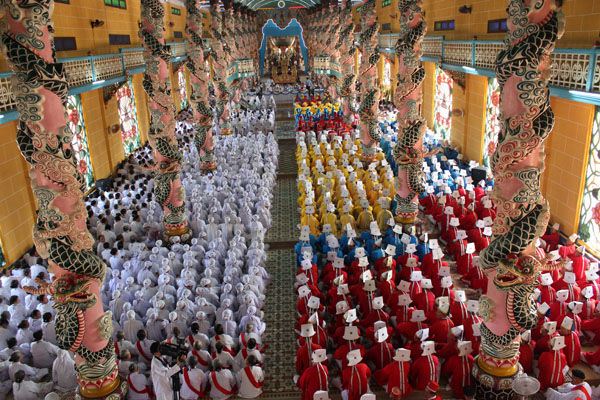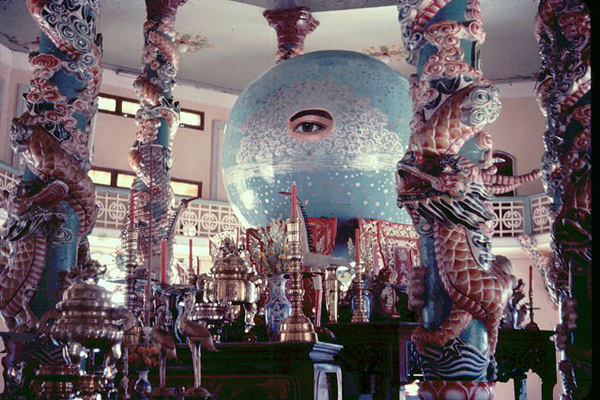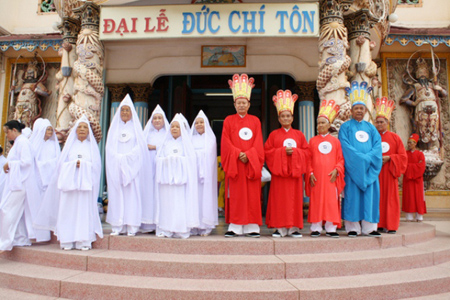Caodaism does not have a system of philosophy- and ideology- based creeds as other religions do. Instead, it is a synthesis or a unity of many religions particularly based on the three traditional religions in Vietnam (Buddhism, Taoism, and Confucianism) with the dominance of Taoism. Its doctrine includes the concepts of "Three Religions" (Tam giao), "Five Religious Branches" (Ngu chi), "Caodaism" (Cao Dai), and "Great Religion of the Third Period of Universal Salvation" (Dai dao Tam ky Pho do), among others.
"Three Religions" is regarded as the center of the Caodaism doctrine. Caodaism believes that their religion is the synthesis of the three largest religions in Asia: Buddhism, Taoism, and Confucianism. It is also said to be the synthesis of five religious branches, including Nhan Dao (Religion of Human Beings) by Confucius, Than Dao (Religion of Gods), Thanh Dao (Religion of Saints), Tien Dao (Religion of Fairies), and Phat Dao (Buddhism). For its mixture of many religions, Caodaism is also called Dai Dao (Great Religion). In Dai dao van dap can nguyen (Questions and Answers about the Origin of the Great Religion), Phoi su (Archbishop) Thai Tho Thanh (Nguyen Ngoc Tho) wrote: "All religions in the world are great; so are their founders. Caodaism aims to synthesize all religions in the world to search for the origin of purity."

The synthesis of many religions in Caodaism is also expressed in its principle, "Mercy - Justice - Humanity." In this principle, "mercy" belongs to Buddhism; "justice" belongs to Confucianism; and "humanity" belongs to Christianity.
Caodaism is said to be the synthesis of religions in the world, but it does not include Islam, Brahmanism, and some other big religions which have hundreds of millions of followers. According to Tran Van Giau, it is possible because there are not many Muslims and Brahmanists in Vietnam and most of them are Cham people. It is possible because the founders of Caodaism wanted to stop at the mysterious number five which often makes its appearance in Buddhism, Taoism, and Confucianism, as in the Five Aggregates of Human Being (Ngu uan), the Five Precepts (Ngu gioi), the Five Basic Elements (Ngu hanh) and the Five Constant Virtues (Ngu thuong).
The synthesis of different religions in Caodaism is manifested clearly in its worship: it worships God and heads of religions. On a Caodaist altar, under the Divine Eye, or the Sun, are the founders of religions worshipped. They include Sakyamuni, Lao Tzu, Confucius, Bodhisattva of Mercy, Li Bai, Kwan Kung, Jesus Christ, and Lu Shang. The Divine Eye became the main worshipping symbol of Caodaism. It is believed that the Divine Eye is like a huge mirror and that everything can be seen through it. The Divine Eye is the symbol of Caodaism, just like the character wan of Buddhism, the cross of Christianity, or the crescent and star of Islam.

The doctrine of Caodaism focuses on the mysterious holiness of Co but. It is credited as the spirit of Caodaism. In 1927, after completing the doctrine, ritual rules, and organization of Caodaism, God stopped using Co but. However, some Caodaist sects still maintained it to make amendments to the doctrine and ritual rules, and especially deal with issues related to dignitaries and the organization and direction of activities. Nevertheless, some Caodaist sects were so interested in Co but that they abused it and therefore exposed negative effects. Pham Cong Tac, the highest Caodaist dignitary, said: "The establishment of Caodaism is due to Co but. Its holiness is due to Co but. Its division into many sects is due to Co but. Its foundation has been undermined due to Co but... Co but is both truth and fiction. Anything that is affected by man's secular intentions is more virtual than real." After 1975, especially after the completion of the Charter of Caodaism and its new direction of activities in the 1990s, all of the Caodaist sects declared to give it up.



